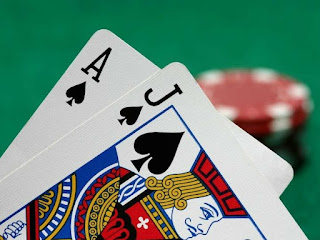Basics of Poker
During the 1830s, the game was refined further and became known as Poker. During the Civil War, the critical guideline about attracting cards to further develop one's hand was added. A variety - Stud Poker - showed up at about a similar time. There are many variants of Poker, and the game is played in private homes, yet additionally in endless Poker rooms at renowned club. Poker can be played socially for pennies or matchsticks, or expertly for huge number of dollars.
There is a lot of karma in Poker, yet the game requires amazingly incredible ability also, and every player is the expert of his own destiny.
THE PACK
The standard 52-card pack, once in a while with the expansion of a couple of jokers, is utilized. Poker is a one-pack game, yet today, in practically all games played in clubs and among the best players, two bunches of differentiating colors are used to accelerate the game. While one pack is being managed, the other is being rearranged and ready for the following arrangement. The methodology for two packs is as per the following: While the arrangement is in progress, the past vendor gathers every one of the cards from the pack he managed, rearranges them, and spots them to one side. At the point when it is the ideal opportunity for the following arrangement, the rearranged deck is passed to the following vendor. In many games in which two packs are utilized, the vendor's left-hand rival, rather than the right-hand rival, cuts the pack.
In clubs, it is standard to change cards regularly and to allow any player to call for new cards at whatever point they wish. At the point when new cards are presented, the two packs are supplanted, and the seal and cellophane wrapping on the new decks ought to be broken in full perspective on every one of the players.
CARD VALUES/SCORING
While Poker is played in countless structures, a player who comprehends the upsides of the Poker hands and the standards of wagering can play without trouble in a Poker game. Besides in a couple of adaptations of the game, a Poker hand comprises of five cards. The different mixes of Poker hands rank from five of a sort (the most elevated) to no combine or nothing (the least):
Five of a Kind – This is the most elevated conceivable hand and can happen just in games where something like one card is wild, like a joker, the two one-peered toward jacks, or the four deuces. Instances of five of a sort would be four 10s and a special case or two sovereigns and three trump cards. 안전한카지노사이트
Straight Flush – This is the most noteworthy conceivable hand when just the standard pack is utilized, and there are no special cases. A straight flush comprises of five cards of a similar suit in grouping, like 10, 9, 8, 7, 6 of hearts. The most elevated positioning straight flush is the A, K, Q, J, and 10 of one suit, and this mix has an exceptional name: a regal flush or an imperial straight flush. The chances on being managed this hand are 1 in just about 650,000.
Four of a Kind – This is the following most noteworthy hand, and it positions just under a straight flush. A model is four pros or four 3s. It doesn't make any difference what the fifth, unrivaled card is.
Full House – This bright hand is comprised of three cards of one position and two cards of another position, like three 8s and two 4s, or three aces and two 6s.
Flush – Five cards, the entirety of a similar suit, yet not all in grouping, is a flush. A model is Q, 10, 7, 6, and 2 of clubs.
Straight – Five cards in arrangement, yet not all of a similar suit is a straight. A model is 9♥, 8♣, 7♠, 6♦, 5♥.
Three of a Kind – This blend contains three cards of a similar position, and the other two cards each of an alternate position, like three jacks, a seven, and a four.
Two Pairs – This hand contains a couple of one position and one more pair of an alternate position, in addition to any fifth card of an alternate position, like Q, Q, 7, 7, 4.
One Pair – This continuous blend contains only one sets with the other three cards being of various position. A model is 10, 10, K, 4, 3.
No Pair – This exceptionally normal hand contains "nothing." None of the five cards pair up, nor are every one of the five cards of a similar suit or successive in rank. At the point when more than one player has no pair, the hands are appraised by the most elevated card each hand contains, so an ace-high hand beats a ruler high hand, etc.
Two hands that are indistinguishable, card for card, are tied since the suits have no general position in Poker. In such a case, the tied players split the pot. Note that assuming two hands contain a similar high pair, the positioning of the following card in the hands figures out which one successes. For instance: 9, 9, 7, 4, 2 beats 9, 9, 5, 3, 2. Similarly, two hands that have indistinguishable sets would be chosen by the fifth card. For instance: Q, Q, 6, 6, J beats Q, Q, 6, 6, 10.
Betting
Betting is the way to Poker, for the game, fundamentally, is a round of chip the board.
Over the span of every Poker bargain, there will be at least one wagering stretches in which the players have a chance to wager on their hands. Limiting misfortunes with helpless hands and augmenting rewards with great hands is the hidden ability that Poker requires.
Before the cards are even managed, the guidelines of the Poker game being played may necessitate that every player put an underlying commitment, called an "bet," of at least one chips into the pot, to get it going.
Each wagering span, or round, starts when a player, thusly, makes a bet of at least one chips. Every player to one side, thus, should by the same token "call" that bet by placing into the pot similar number of chips; or "raise," which implies that the player places in a very sizable amount of chips to call; or "drop" ("crease"), which implies that the player places no chips in the pot, disposes of their hand, and is out of the wagering until the following arrangement.
At the point when a player drops, they lose any chips that have placed into that pot. Except if a player will place into the pot basically however many chips as any first player, they should nonconformist.
A wagering span closes when the wagers have been evened out - that is, the point at which every player has either placed in precisely however many chips as their archetypes or has dropped. There are normally at least two wagering spans for every Poker bargain. After the last stretch there is a "confrontation," which implies that every player who remains shows their hand face up on the table. The best Poker hand then, at that point, takes the pot.
If a player makes a bet or a raise that no other player calls, they win the pot without showing their hand. Subsequently, in Poker, there is a feigning component, and the best blend of cards doesn't generally win the pot! Feigning is one of the key justifications for why Poker is so famous.
If a player wishes to stay in the game without wagering, they "check." This implies, as a result, that the player is making a "bet of nothing." A player might check gave nobody before them in that wagering span has made a wagered. On the off chance that another player has wagered, they can't check however should basically call the bet or drop. A player who checks might raise a bet that has been raised by another player. This is classified "obstructing," which is permitted, except if it has been chosen ahead of time that this training is taboo. In the event that all players check during a series of play, the wagering stretch is finished, and every one of the players still in the pot stay in the game.
In each wagering cycle, one player is assigned as the main bettor, as per the standards of the game. The go to wager consistently moves to one side, from one player to another, and nobody might check, bet, or even drop, with the exception of when it is their move.
KNOWING WHEN TO BET
The positioning of Poker hands depends on science. The more uncertain a player is to get a specific hand, the higher it positions and the almost certain it is to win the pot. For instance, a player ought not anticipate being managed a straight flush more than once in 65,000 hands, yet they can hope to be managed two sets about once in each 21 hands.
Except if a player is intending to feign, they ought not make a bet without holding a hand that they think might be awesome. No Poker player can wager insightfully except if they realize what comprises a decent hand, a reasonable hand, and a terrible hand. A table of the different Poker hands and the quantity of mixes of each in a bunch of cards is given. 바카라사이트

.jpg)


Comments
Post a Comment